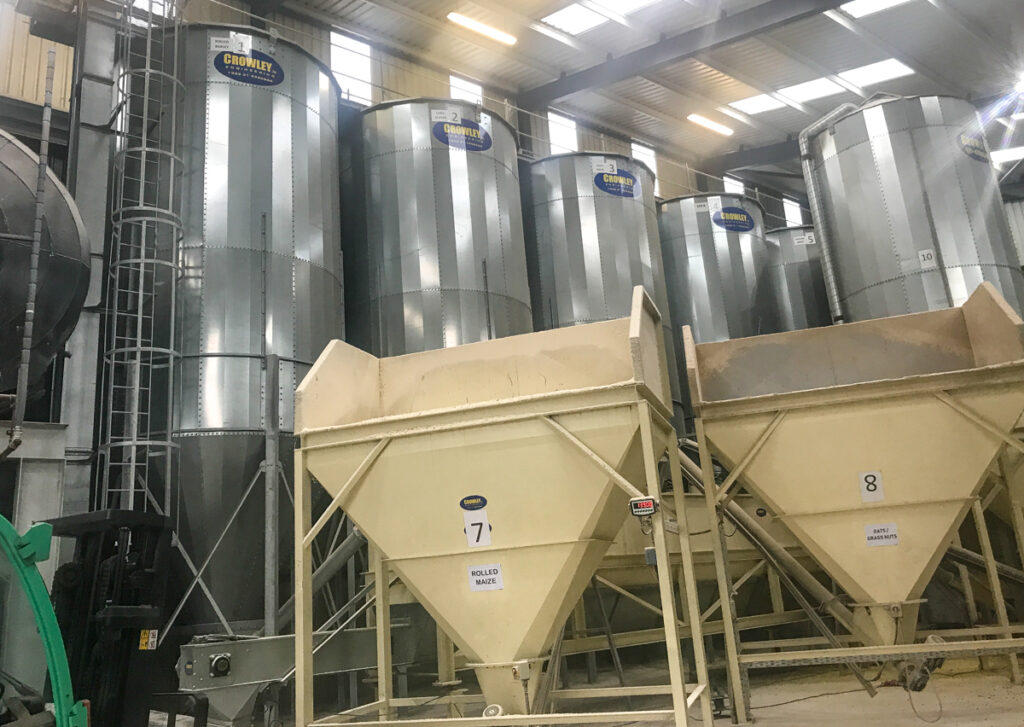‘From little acorns mighty oak trees grow.’ That well known phrase isn’t a bad description of what happened to John Cullen’s business.
John is a tillage farmer from Co. Wexford and in 2005 he set about adding value to his product by drying grain.
He then began to buy grain from local farmers. 12 years later, John opened a feed mill which takes in grain and sells feed to an area that is largely in a 20 mile radius of that mill.
Speaking to the Co. Wexford man, he doesn’t make a big deal of his achievement. The mill is an impressive sight and employs 12 people on a full-time basis – including a full-time agronomist, Larry Kirwan – as well as four to five seasonal workers.
Two original farm sheds now act as stores for chemicals and animal minerals. The remainder of the yard, which has made its way out to the tillage fields, is taken up by grain stores and the newly built mill.
John and Karen Cullen told AgriLand how it all happened.
“John’s father died in 2003 and he used to haul the grain. So, for logistics reasons we decided to dry our own grain and store it; then, we started to buy other peoples’ grain,” John explained.
John Cullen Grain developed out of that from 2005 and gradually built up each year.
“We started selling animal feed in 2014 and 2015. We saw that there was an opportunity to open up our own mill, to utilise our own grain – that we had on site – and in 2016 we started to build the plant. We officially opened in 2017. It’s been building from day one.
We can’t believe how well the mill has taken off, with a lot of repeat custom.
“When we started John Cullen Grain we had two portacabins and the two farm sheds. We built the first grain store in 2005.”
John Cullen Grain is a family-run business. John and his wife Karen, along with their daughter Caoimhe all work in the business.
“Caoimhe is involved. She’s been working on the weighbridge since she was 13 and she’s doing business in college,” Karen noted.
The tillage farm
John is farming away while he runs the mill and farm shop.
“We’re still battling away. We work very closely with my brothers – Francis and Stephen. Francis looks after all of the tilling and harvesting of the crops. Stephen does all of the baling. We look after the fertiliser spreading and spraying.”
Fueling the mill with local grain
The mill is supplied by barley, wheat and oats from John’s own farm and the large customer base. Surplus grain is also sold to the market.
Locally sourced beans supply some of the protein to the plant, but soybeans also need to be bought in. John encouraged local farmers to grow beans and he often finds himself in a position where he is selling beans.
Soybeans, hulls and maize are the only products coming off the boat.
We’re generally self-sufficient in wheat, barley and oats. We don’t have enough oats this year; they were very scarce, but last year we had a surplus of oats.
“One of the reasons we wanted to start the mill is that we were stuck with beans and oats in other years. If you have the mill you have the flexibility to use the oats against soya hulls, for example.
“This year, you can get more for the oats, but before the oats were coming in very cheap in comparison to soya hulls,” John explained.
We got in enough beans this year to be sufficient for our own mill, but we used to supply other mills; that didn’t happen this year. We’re still topping up with soybeans.
John supplies feed to the dairy, beef, sheep and equine sectors.
“We do the complete range. Dairy has grown and farmers like to know exactly what they’re getting in the ration. A lot of the new dairy farmers are putting in the facilities to use coarse grain.”
Off to a busy start
The mill officially opened in 2017. The winter of 2017/2018, along with the summer of 2018, were busy ones.
“The summer was very busy in July and August. We were busy with the mill and with grain coming in at harvest time. We run from 7:00am to 9:00pm.
We don’t want to go to 24 hours. We want everyone to have a normal life.
Forage crops
During the busy summer of 2018, John took the initiative to sow forage crops himself and to encourage local farmers to sow these crops. He held an open day in conjunction with Teagasc and Goldcrop in July.
This was an important move as Co. Wexford was one of the worst hit areas by the summer’s drought. It is also the county which had the highest number of applications under the Fodder Production Incentive Measure. The majority of farmers zero-grazed or grazed these crops.
“The forage crops worked out well. They’re still harvesting those crops. It’s not ideal to be zero-grazing at this time of the year. Farmers can only get into some fields, but they are still able to get out.
The forage crops definitely lightened the deficit. We had one farmer who baled a crop of forage rape and we still have to see how that worked out.
John didn’t opt to sow temporary grasses. Seed was difficult to obtain for the optimal sowing time, but John was also wary about these crops, due to weed seeds if they weren’t harvested on time.









